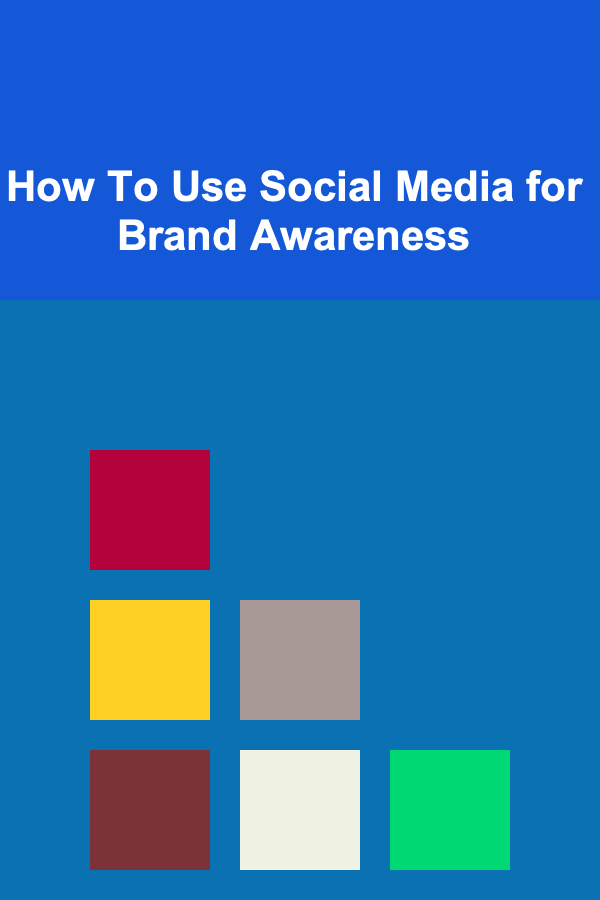
How To Use Social Media for Brand Awareness
ebook include PDF & Audio bundle (Micro Guide)
$12.99$9.99
Limited Time Offer! Order within the next:

Social media has become an indispensable tool for businesses seeking to establish and grow their brands. With billions of active users across various platforms, social media presents an unparalleled opportunity for companies to increase brand awareness, engage with their audience, and drive business success. This article delves deep into the strategies, best practices, and insights on how to effectively use social media to enhance brand awareness.
The Role of Social Media in Brand Awareness
Brand awareness refers to the extent to which consumers recognize or recall a brand. It is the foundational first step in the marketing funnel, where the primary objective is to make people aware of the existence of a product or service. Social media platforms, including Facebook, Instagram, Twitter, LinkedIn, TikTok, and others, provide a direct line to billions of users, making them ideal for increasing visibility and fostering recognition.
The dynamic and interactive nature of social media allows brands to connect with their target audience in real-time. This makes it easier for brands to establish a unique identity, showcase their products and services, and initiate meaningful conversations with potential customers. When used correctly, social media can significantly elevate a brand's visibility, helping it stand out in a crowded market.
Understanding Your Target Audience
The foundation of any successful social media strategy begins with understanding your target audience. Every brand has a unique customer profile, and knowing who your audience is, where they spend their time, and what content they engage with is key to creating effective brand awareness campaigns.
1.1 Defining Your Audience
Before crafting your social media posts, it's important to understand who your ideal customers are. Use tools like Google Analytics, social media insights, and customer surveys to gain a deeper understanding of your audience's demographics, behaviors, interests, and pain points. This information will allow you to tailor your messaging to resonate with your audience, ensuring that your content speaks directly to their needs and desires.
1.2 Segmenting Your Audience
Once you've gathered data about your target audience, segment them into specific groups based on factors such as age, location, income level, and interests. This segmentation allows you to personalize your messaging and create campaigns that speak to each group individually. For example, a fashion brand might create distinct campaigns for teenagers, young adults, and older professionals, ensuring that each group feels personally addressed.
Choosing the Right Social Media Platforms
Each social media platform has its own unique features, user base, and culture. Selecting the right platforms for your brand is crucial to achieving the desired results. The key is to focus on platforms where your target audience is most active.
2.1 Facebook
Facebook is the largest and most established social media platform, making it an essential tool for brand awareness. It is particularly effective for reaching older demographics and individuals in suburban and rural areas. The platform's advertising capabilities, including targeted ads and retargeting, allow brands to reach specific audiences based on their interests, behaviors, and past interactions with the brand.
2.2 Instagram
Instagram, known for its visual appeal, is an ideal platform for brands in industries such as fashion, beauty, food, and lifestyle. The platform's image and video-based content allow brands to showcase their products in creative ways. Instagram also has a highly engaged audience, particularly among younger demographics, making it a great choice for brands looking to build awareness among millennials and Gen Z.
2.3 Twitter
Twitter is perfect for real-time updates and engagement with a wide audience. It's a great platform for brands looking to join conversations, share news, and interact with their followers. Hashtags and trending topics also make Twitter an excellent tool for tapping into viral conversations and increasing visibility.
2.4 LinkedIn
LinkedIn is the go-to platform for businesses looking to reach professionals and other businesses. It's a powerful tool for B2B companies seeking to increase their brand awareness in a professional setting. LinkedIn is also ideal for thought leadership content, where brands can share articles, case studies, and industry insights to establish credibility and foster trust.
2.5 TikTok
TikTok has rapidly become one of the most popular social media platforms, especially among younger audiences. It is ideal for brands looking to create viral, short-form videos that entertain and engage users. The platform's algorithm makes it easier for content to go viral, even if you're just starting out, which is why it's an excellent tool for building brand awareness quickly.
Creating High-Quality Content
Content is the backbone of any social media strategy. To build brand awareness, you need to create content that is engaging, valuable, and relevant to your target audience. Your content should reflect your brand's voice, values, and personality.
3.1 Visual Content
On social media, visuals are often the first thing users notice. Posts with images, videos, and graphics tend to receive higher engagement rates compared to text-based content. High-quality visuals help capture your audience's attention and communicate your brand's identity in a way that words alone cannot.
Consider creating high-quality photos, infographics, product demonstrations, behind-the-scenes content, and user-generated content to showcase your brand's offerings. The more visually appealing and authentic your content, the more likely it is to be shared, helping to increase your brand's reach.
3.2 Consistency in Branding
Your brand's visual identity should remain consistent across all social media platforms. Use the same color scheme, logo, and typography in your posts to create a cohesive brand experience. This consistency helps reinforce your brand's image, making it more recognizable and memorable to your audience.
3.3 Value-Driven Content
While entertainment is important, your content should also provide value to your audience. Offer educational content, tips, tutorials, or problem-solving advice that speaks directly to your audience's needs. By providing real value, you establish trust with your audience and position your brand as an expert in your field.
3.4 User-Generated Content (UGC)
User-generated content is a powerful way to build brand awareness, as it provides social proof and shows that people trust and love your products or services. Encourage your followers to share their experiences with your brand by creating a branded hashtag or running a contest. Reposting UGC on your social media channels not only increases your brand's credibility but also helps foster a community of loyal customers.
Engagement: Building Relationships with Your Audience
One of the most powerful aspects of social media is the ability to engage directly with your audience. Unlike traditional marketing channels, social media allows for two-way communication, which fosters deeper relationships and creates a sense of community.
4.1 Responding to Comments and Messages
Engagement begins with active participation. Respond to comments on your posts, answer questions in direct messages, and engage with your followers' content. By doing so, you show that you value their input and are committed to building a relationship. Engagement increases the likelihood of your followers sharing your content, which amplifies your brand's reach.
4.2 Running Polls and Surveys
Polls and surveys are great ways to involve your audience in the conversation. They not only encourage engagement but also provide valuable insights into what your audience likes or dislikes. Use polls and surveys to gather feedback on new products, ideas, or marketing campaigns.
4.3 Hosting Giveaways and Contests
Giveaways and contests are proven methods for generating buzz and increasing brand awareness. By offering a prize, you incentivize people to engage with your brand. Encourage participants to follow your account, tag their friends, or share your content to maximize the reach of your campaign.
4.4 Collaborations and Influencer Marketing
Partnering with influencers or other brands in your industry can help extend your reach to new audiences. Influencers, especially those with a large following, can provide exposure for your brand that might be difficult to achieve otherwise. Choose influencers whose values align with your brand to ensure that the partnership feels authentic and resonates with their followers.
Paid Social Media Advertising
While organic content is valuable, paid advertising on social media can provide a significant boost to brand awareness. Social media platforms offer advanced targeting options that allow you to reach specific demographics based on factors such as location, age, interests, and behaviors.
5.1 Types of Paid Advertising
Each social media platform offers different types of ads to suit your goals. For example:
- Facebook and Instagram: Sponsored posts, carousel ads, and story ads.
- Twitter: Promoted tweets and trends.
- LinkedIn: Sponsored content and InMail ads.
- TikTok: In-feed ads and branded challenges.
Each ad type offers unique features and can be tailored to meet your objectives, whether it's increasing brand awareness, driving website traffic, or generating leads.
5.2 Retargeting
Retargeting is a powerful strategy for reaching people who have already interacted with your brand, whether it's by visiting your website or engaging with your social media content. By showing ads to these individuals, you increase the likelihood of conversion while reinforcing your brand's presence in their minds.
Measuring Success
To ensure your social media efforts are driving brand awareness, it's crucial to track key metrics and analyze the performance of your campaigns. Metrics like reach, impressions, engagement rate, and follower growth give you insights into how well your content is resonating with your audience.
6.1 Tools for Social Media Analytics
Platforms like Facebook Insights, Twitter Analytics, and Instagram Insights offer native tools to track your social media performance. Additionally, third-party tools such as Hootsuite, Buffer, and Sprout Social can provide in-depth analytics across multiple platforms.
6.2 Refining Your Strategy
Based on the data you collect, continuously refine your social media strategy. If certain types of content are performing better than others, adjust your future campaigns to focus on those formats. Experiment with different ad creatives, post times, and targeting strategies to find what works best for your brand.
Conclusion
Social media is an incredibly powerful tool for increasing brand awareness, but it requires a well-thought-out strategy, consistent effort, and a deep understanding of your audience. By choosing the right platforms, creating engaging content, fostering relationships, and leveraging paid advertising, brands can effectively use social media to grow their presence and connect with their target market. Remember, social media success doesn't happen overnight, but with patience, creativity, and strategic planning, your brand can build lasting awareness and drive long-term success.

How to Install Noise Canceling Wall Foam in Your Media Room
Read More
How to Keep Your Sewing Machine Area Clutter-Free
Read More
How to Manage Your Investment Property Efficiently
Read More
How to Negotiate Better Deals for Home Services
Read More
How to Revive Your Old Rugs with Simple Cleaning Tips
Read More
How To Teach Children About Money
Read MoreOther Products

How to Install Noise Canceling Wall Foam in Your Media Room
Read More
How to Keep Your Sewing Machine Area Clutter-Free
Read More
How to Manage Your Investment Property Efficiently
Read More
How to Negotiate Better Deals for Home Services
Read More
How to Revive Your Old Rugs with Simple Cleaning Tips
Read More